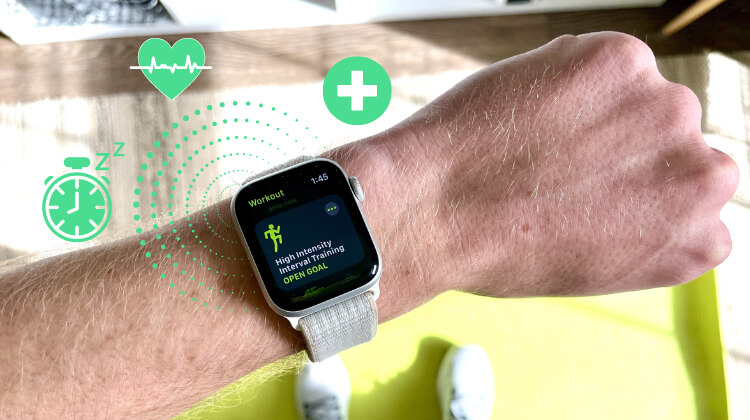Healthcare App Developers: Watch Out for watchOS 9

At WWDC 2022, Apple gave a sneak peek at watchOS 9 that probably made a few healthcare app developers take notice.
Why? Because Apple has added several new mHealth apps and features that healthcare app developers can capitalize on.
The OS update adds sleep stages to the Sleep app, an AFib History feature, and an all-new Medication tracking and reminder app.
Apple also updated the watchOS fitness apps.
Healthcare app development companies will no doubt use these new apps as a springboard to innovation, as providers seek to integrate this new data into care plans.
Here’s a quick look at the watchOS 9 features and apps that will interest healthcare app developers.
Sleep Tracking
Sleep tracking apps are not a new healthcare technology trend. And Apple Watch users have been able to create bedtime schedules and track their sleep for a while.
With watchOS 9, sleep tracking gets more detailed. Apple Watch will now provide detailed information on users’ sleep stages.
The device uses machine learning and data from the accelerometer and heart rate sensor to detect when users are in REM, Core, or Deep sleep. Users will see sleep stage data in the Sleep app.
But sleep tracking doesn’t stop there. Users can find more detailed sleep information in the Health app on their iPhones.
In addition, the Health app will show them how long they were asleep and their sleeping heart rate and respiratory rate.
Apple boasts that their machine learning models were trained by and validated against polysomnography – “the clinical gold standard” – with one of the largest and most diverse populations ever studied for a wearable.
Sleep experts say that sleep tracking mHealth apps are often inaccurate. They’ve previously cautioned people against relying on what a wearable device says about their sleep quality—good or bad. It will be interesting to see how they react to Apple’s sleep tracking capabilities.
Atrial Fibrillation History
Apple introduced the watchOS ECG app in 2018 and irregular heart rhythm notifications even earlier. The app carefully states that while it can detect atrial fibrillation (AFib), it cannot detect heart attacks.
Nevertheless, the ECG app attracted more attention to the Watch. For the first time, users could take an ECG reading anytime, anywhere. And that made it one of the best medical apps Apple has released to date.
And in watchOS 9, Apple is expanding the ECG functionality to track the user’s AFib history.
AFib increases the risk of heart attacks and strokes. According to the American Heart Association, at least 2.7 million Americans suffer from this heart condition. That number is likely higher, though, because many people don’t realize they have AFib.
Apple’s addition of AFib tracking to watchOS 9 may change that. Now, Watch users will have a way to track the frequency of AFib over an extended period.
The new AFib History feature will show users how frequently their heart rhythm indicates AFib. They will also get weekly notifications via Apple’s Health app and recommendations for lifestyle factors that may influence AFib, like sleep, alcohol consumption, and exercise.
Users can also share their detailed AFib history with their doctors and care providers.
This new tracking feature could make the Apple Watch a vital piece of healthcare information technology for AFib patients.
Cardio Recovery
Another heart-related new feature is Cardio Recovery. This fitness metric can be an indicator of cardiovascular health.
Apple Watch will provide estimates of Cardio Recovery after an Outdoor Walk, Run, or Hiking workout, even when the activity does not reach peak intensity.
And users can also track their cardio recovery stats over time in the Health app.
Medication Reminders
Many medications have to be taken regularly, or their health benefits diminish. Nevertheless, remembering to take medications is a problem for many people.
Watch users, however, will have a new tool to prompt them—as well as warn them about dangerous drug interactions.
The watchOS 9 Medications app will allow users to add the drugs they take by scanning the pharmacy label or selecting from a pre-loaded list of medicines.
They can then set a schedule for each drug they take. The user’s Watch will remind them each time they need to take a dose.
And although it will only work for US users initially, the Medications app will alert users if there are dangerous interactions between the drugs they take.
Healthcare App Developers Take Note
WatchOS 9 pushes Apple Watch closer to becoming an integrated healthcare device. And new watchOS APIs should spur developers to build high-quality third-party apps with support for many of the native Watch features.
Healthcare innovators and mobile app development companies will likely develop new types of healthcare apps based on watchOS 9.
Apple has already made the developer beta of watchOS 9 available to Apple Developer Program members. A public beta will be available to watchOS users next month, and the full release of watchOS 9 is promised for this fall.

